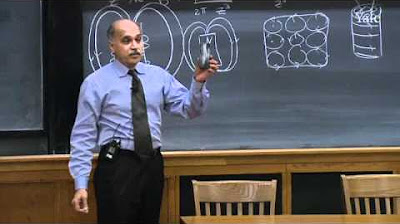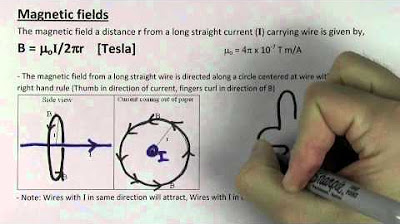Measuring the Magnetic Force
TLDRIn this AP Physics essentials video, Mr. Andersen explores the magnetic force by demonstrating how a falling magnet induces a current in a copper pipe, creating a magnetic force that slows its descent. He explains the concept of magnetic dipoles and how they interact with magnetic fields, using the right-hand rule to determine the direction of the force on moving charges. The video further illustrates the relationship between electricity and magnetism, showing how current through a wire generates a magnetic field. Finally, Mr. Andersen suggests experiments with a solenoid to understand how varying current, coil numbers, and distances affect the magnetic field's strength, encouraging students to apply the right-hand rule and plan data collection to measure magnetic fields.
Takeaways
- 🧲 The video demonstrates measuring magnetic force by observing a magnet falling through a copper pipe and the induced current slowing its descent.
- 🌀 As the magnet falls, it induces a current in the copper pipe, which in turn creates a magnetic force that opposes the magnet's motion.
- 📍 Magnets are magnetic dipoles with a north and a south pole, visualized as a vector running through the middle with the poles at each end.
- 🔗 The magnetic force always acts when there is an interaction between electric charges or magnets, and it can cause objects to orient towards a magnetic field.
- 👆 The right-hand rule is used to determine the direction of the magnetic force on a moving charge in a magnetic field.
- 🌐 Magnetic fields are not always linear and can be visualized using iron filings, which align with the field lines, showing the orientation of magnetic dipoles.
- 🔌 When current is run through a wire, it generates a magnetic field, as demonstrated by the alignment of compass needles around the wire.
- 🔄 The right-hand rule helps to determine the direction of the magnetic field around a current-carrying wire, with fingers wrapping around the direction of current flow.
- 🔗 Running current through a loop of wire creates a magnetic dipole, with the magnetic field running through the center of the loop.
- 🧭 A PHET simulation shows how a compass orients towards the magnetic field produced by both a magnet and a current-carrying wire.
- 🧬 Increasing the number of wires or the current in a solenoid increases the strength of the magnetic field, illustrating the link between electricity and magnetism.
Q & A
What is the phenomenon shown in the video where a magnet falls through a copper pipe?
-The magnet appears to hover as it moves through the copper pipe due to the induction of a current in the copper, which in turn produces a magnetic force that slows the magnet's descent.
What causes the magnetic force that slows down the magnet falling through the copper pipe?
-The magnetic force is caused by the interaction between the falling magnet and the induced current in the copper pipe, which is a result of the magnet's movement through the pipe.
What are the essential properties of a magnet according to the script?
-A magnet is essentially a magnetic dipole with a north and a south pole. It cannot be broken in half without creating two new magnetic dipoles, and the north and south poles cannot be separated.
How can the orientation of a magnet in a magnetic field be visualized?
-The orientation can be visualized using a vector that goes through the middle of the magnet, with the north pole at the tip of the arrow and the south pole at the end of the arrow.
What is the right-hand rule, and how is it used in the context of magnetic fields?
-The right-hand rule is a mnemonic tool used to determine the direction of the magnetic field around a current-carrying conductor. You point your thumb in the direction of the current flow, and your fingers will wrap around in the direction of the magnetic field.
Why do compass needles align with the magnetic field when current is run through a wire?
-Compass needles align with the magnetic field because the moving charge (current) in the wire produces a magnetic field, influencing the orientation of the magnetic dipoles in the compass needles.
How does the magnetic field around a straight current-carrying wire look like?
-The magnetic field around a straight current-carrying wire wraps around the wire in concentric circles, with the direction determined by the right-hand rule.
What happens to the magnetic field when a wire is formed into a loop?
-When a wire is formed into a loop, the magnetic field lines pass through the center of the loop, creating a magnetic dipole with a field similar to that of a bar magnet.
How does increasing the number of wires in a solenoid affect the magnetic field?
-Increasing the number of wires in a solenoid increases the strength of the magnetic field due to the cumulative effect of the individual magnetic fields produced by each wire loop.
What is a solenoid and how can it be used to study magnetic fields?
-A solenoid is a coil of wire that, when an electric current is passed through it, produces a magnetic field. It can be used in experiments to study the effects of variables such as current strength, number of coils, and coil geometry on the magnetic field.
What is the unit of measurement for magnetic field strength mentioned in the script?
-The unit of measurement for magnetic field strength mentioned in the script is teslas.
Outlines
🧲 Understanding Magnetic Force and Induced Current
In this segment, Mr. Andersen explores the concept of magnetic force through an experiment involving a falling magnet and a copper pipe. He explains that as the magnet falls, it induces a current in the copper, creating a magnetic force that slows its descent. This phenomenon is a demonstration of the interaction between magnets and electric charges or other magnets. Magnets are described as magnetic dipoles with a north and south pole, and Mr. Andersen uses the analogy of a vector to visualize this. The video also touches on the concept of magnetic fields and how they influence the orientation of magnets and moving charges, using the right-hand rule to determine the direction of the force.
🔌 Experimenting with Solenoids and Magnetic Fields
The second paragraph delves into the relationship between electricity and magnetism, specifically focusing on the creation of magnetic fields by moving charges. Mr. Andersen discusses how running current through a wire induces a magnetic field, which can be visualized using iron filings. He then introduces the concept of a magnetic dipole created by running current through a loop of wire. The paragraph continues with a discussion on increasing the magnetic field's strength by adding more wires or adjusting the current. Mr. Andersen suggests several experiments that could be conducted using a solenoid, such as varying the current, changing the number of coils, or altering the distance between coils to measure the magnetic field's strength. The right-hand rule is reiterated as a method to determine the direction of the magnetic field lines, and the paragraph concludes with an encouragement to understand how current movement affects the magnetic field.
Mindmap
Keywords
💡Magnetic force
💡Magnetic dipole
💡Right-hand rule
💡Magnetic field
💡Induced current
💡Electric charge
💡Iron filings
💡Solenoid
💡Rheostat
💡Magnetic probe
💡Compass
Highlights
Demonstration of measuring magnetic force by dropping a magnet through a copper pipe.
Observation of the magnet appearing to hover due to induced current in the copper pipe.
Explanation of the magnetic force slowing the magnet's descent in a copper pipe.
Magnetic force's role in interactions between electric charges or magnets.
Magnetism as a property of magnetic dipoles with north and south poles.
Inability to separate north and south poles of a magnet.
Magnetic field's influence on magnets and moving charges.
Use of the right-hand rule to determine direction of magnetic force on moving charges.
Examples of magnetic dipoles, such as the Earth and a compass needle.
Visualization of magnetic field lines using iron filings.
Discovery of the relationship between electric current and magnetic fields.
Application of the right-hand rule to determine the direction of magnetic fields around a wire.
Magnetic field patterns around a loop of wire creating a magnetic dipole.
Demonstration of a compass orienting towards a magnetic field produced by an electric current.
Experiment with increasing the number of wires to strengthen the magnetic field.
Introduction of a solenoid as a tool to study magnetic fields.
Experimentation with a slinky as a solenoid to measure magnetic field strength.
Use of a magnetic probe to measure the strength of the magnetic field in a solenoid.
Suggestions for labs to explore variables affecting magnetic field strength.
Teaching the right-hand rule for determining magnetic field lines.
Planning data collection to measure the effect of electric current movement on magnetic fields.
Transcripts
5.0 / 5 (0 votes)
Thanks for rating:





